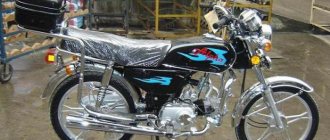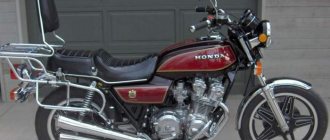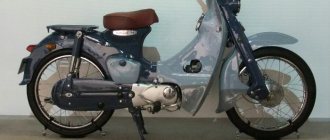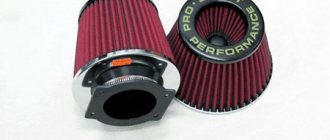History of appearance
This Russian passenger car was produced from 1992 to 1997. The base model is considered to be 2410, and the car's body parts came from version 3102. In the early 90s of the last century, the new Volga was purchased for government needs and was also offered to private owners. The prestige of the car led to good demand among the population.
The development of the GAZ 31029 car began back in the 80s of the twentieth century. This was the second point of the program to improve the GAZ 24. The first part of this program was designed to modernize the mechanical component. And we took up the appearance a little later. At the same time, the government did not consider it appropriate to make the body similar to the 3102. Thus, the 29 differs in some details. There is a different hood, fenders, radiator grille, original bumpers.
The GAZ 31029 car was launched into production in 1992. This was the first car produced after the collapse of the Soviet Union. The exterior was perceived differently, and demand increased. Since 1996, the car began to be equipped with modern engines from ZMZ, an injector, new rear axles, and disc brakes. Many owners of the GAZ 31029 car did the tuning themselves, as a result they were able to significantly improve the comfort of the car and its appearance.
GAZ-31 10 "Volga"
In the early 1990s, the Gorky Automobile Plant launched the car model 31029. The car body combined elements of the more expensive Volga 3102 and the original design of the front part using the lighting technology of the then promising Gazelle. The machine, created at an emergency pace, turned out to be quite successful and allowed the plant to stay afloat in difficult years.
New restyling of the GAZ-31029 sedan
By the mid-90s, interest in the base model began to decline. The quality of the cars and components was low, the body was not resistant to corrosion. The growing import of used foreign cars also played a role, against the background of which GAZ products looked clearly outdated.
Thanks to good demand for Gazelle in the second half of the 90s, the plant had working capital. This money was used to modernize the production of passenger cars.
The transition to a new model under the symbol GAZ-31 10 "Volga" began in stages from the end of 1996. Transitional versions in the body of the previous model were equipped with new front wheel brakes, power steering, new 15-inch diameter wheels and other components.
For some time, hybrid cars were produced, they had a completely new body and interior combined with the front end from the GAZ-31029. Very few such cars were produced. Completely updated GAZ-31 10 began to be assembled in May 1997.
New appearance
The plant's designers faced a difficult task - to get a new look for the car while maintaining the central part of the body. The front of the car received new fenders, a hood, and a front panel with a radiator grille. It was not possible to introduce new headlights on the Volga 31 10, so they remained from the previous model.
The rear of the car has changed a lot. The new rear part of the GAZ-31 10 was almost 10 cm shorter than its predecessor. Due to the rounded corners, it was possible to visually narrow the silhouette of the car, eliminating the feeling of heaviness. The trunk lid was brought almost to the edge of the bumper. This solution made it possible to reduce the loading height and facilitate loading and unloading of the luggage compartment.
But such changes did not leave room for a spare wheel in the fender well. The spare wheel was moved to a stand in the back of the trunk. This arrangement of the wheel greatly reduced the volume of the trunk of the Volga 31 10. But the volume of the gas tank increased to 70 liters. Some cars were equipped with an old 55-liter tank.
New salon
Big changes have taken place inside the car. The car received a new instrument panel with a soft plastic housing. The instrument cluster was equipped with a tachometer, which had never before been found on production GAZ vehicles. The new steering wheel could theoretically be equipped with an airbag. But not a single GAZ-31 10 was equipped with it. One thing remains unchanged - the steering column is offset laterally relative to the instrument cluster.
The interior was equipped with reshaped seats with the ability to adjust the lumbar support in the driver's seat. Molded door cards began to be made of plastic, although early GAZ-31 10s may have had old cards from the previous model.
Engine and transmission
The new Volga also received a new engine. The new ZMZ-406 engine made it possible to significantly improve the technical characteristics of the GAZ-31 10. The engine was equipped with four valves per cylinder, a fuel injection system and developed up to 150 horsepower (later corrected to 145 hp). It is worth noting that a small part of the GAZ-31 029 in 1996-1997 was already equipped with such an engine.
Part of the GAZ-31 10 was equipped with an old ZMZ-402 carburetor engine. The motor existed in two versions, differing in the degree of compression. The engine for A92 gasoline developed up to 100 hp, the derated version for A80 - no more than 90 hp. It had a simpler design and was easier to repair and maintain. These circumstances determined its high popularity among buyers.
Both engine options were equipped with a new five-speed gearbox with synchronizers in all forward gears. Optionally, the car was equipped with a hydraulic booster, front disc brakes of an improved design and a new rear axle. The latter received a design with a continuous crankcase and was popularly called “Tchaikovsky”.
To improve handling, the designers changed the angles of the front suspension units and used tires with a larger tread width.
Subsequent upgrades
In 2000, the car received new plastic bumpers with elements painted in body color and a chrome trim on the top. A year later, the painting process was improved and metallic paints were introduced into the color scheme. Since the spring of 2003, the king pins have been removed from the front suspension, replacing them with ball joints.
Further changes in design and construction led to the appearance in 2004 of another modernized Volga GAZ-31105. With the start of production of this version, production of the GAZ-31 10 ceased.
fb.ru
Modifications
In nature, there were several configurations of these models. You can note the folk version and luxury cars. These are 31029-50 and 31029-51. They differed in the sixteen-valve carburetor ZMZ 4063 or the injection ZMZ 4062. The latter worked only with a five-speed gearbox. The luxury package included a suspension that was copied from the luxury version 3102. Thanks to the suspension and new brakes, hatch 29s have become more prepared for driving at high speeds. Such cars were prized among bosses who liked to look more modest. The base engine of the GAZ 31029 is ZMZ 402 with a volume of 2.5 liters. There were several of these engines. There were modifications for 92nd and 76th gasoline. The power units differed in different cylinder head heights and power ratings.
Weaker units were used as taxis. When buying a car with such an engine, it was necessary to find out where and how it had been used previously. Also, the taxis, in addition to the engine, were distinguished by a vinyl interior and the presence of a lamp on the ceiling. There was also a modification for gas. It can be identified by two refueling hatches on the rear wing. There were also 29s, which were equipped with engines from Rover and Toyota. Such cars were assembled by small companies.
Interior tuning: how do they usually change a car?
The interior is also subject to tuning. The work can be very different, but most often it is performed:
1. Isolation. Even in the case of car restoration, these works are performed. Insulation of the interior involves the dismantling of all old trim and equipment, after which roll and other insulating material is laid.
2. After reaching the required level of insulation to eliminate the possibility of noise in the cabin, various elements are installed: the center console, tunnel, seats, decorative panels, and so on.
3. Another common method of upgrading a car is installing an electric window. It significantly increases the comfort of the car.
4. Quite common methods of decorating the interior include creating unusual lighting, installing a new instrument panel, installing a multimedia system or a high-quality player.
And of course, when finishing you can use a variety of materials: from genuine leather to textiles. You can carry out the interior trim yourself, but the work is quite intricate and requires certain skills. Today there are a large number of companies that provide similar services.
Body
This is one of the main advantages of the GAZ 31029. The car body is not just big, it is huge. The cabin can comfortably accommodate even five people. But the front seats are still not entirely successful. Tall car enthusiasts will literally rest their heads on the roof. If you compare the body with the 2410 model, you will see that the 29 has received newer solutions at the front. It uses aerodynamic contours, an inclined radiator grille, and rectangular headlights. The turn signals are integrated into the front fenders. The body kit allows the car to provide better aerodynamic characteristics and reduce noise. New halogen headlights illuminate the roadway 30 percent brighter. New front fenders and a spoiler under the bumper have reduced windshield splashing. The bumpers are made of plastic, so they are not subject to corrosion. The body is poorly protected from corrosion. This is one of the disadvantages. If a car enthusiast constantly processed iron, then the car could “survive” to this day. When purchasing a used car, you need to carefully look at the wheel arches and rear apron. The most common failures occur due to metal fatigue. It's not very durable. Look at the GAZ 31029 for yourself (photos can be seen in the article).
If corrosion is not eliminated in time, the body will have to be completely or partially digested. And these are additional costs and a huge waste of time.
Do you need a body kit for the GAZ 3110?
The body kit implies a sporty appearance of the car. therefore, the too bright exterior and the classic shape of the 3110 may not go together, although this is a matter of everyone’s taste.
In the factory version, additional body kit parts (sill plates, front and rear bumper covers) are difficult to purchase, so it is necessary to order their production individually from tuning workshops. This is expensive, but very effective, since there is a high probability that your car will be one of a kind. If you have enough experience, you can make these elements with your own hands.
In order to reduce ground clearance, it is not necessary to radically modernize the suspension; it is enough to install universal overhead plastic sills. Products that protrude outward with a simple configuration and have a minimum number of bends are suitable. Their installation will visually lower the car. However, this effect can be achieved if the door sills are of the same color as Volga. You can install them yourself. They may need to be modified at the installation site. To do this you will have to use an angle grinder or a hair dryer.
When considering tuning external elements, for example, a trunk spoiler, pay attention to the shape of the car. A sliding spoiler made of aluminum will look ridiculous in the photo of the Volga 3110 tuning and in real life
It is better to choose a streamlined element of low height with built-in LED lamps that light up when you press the brake pedal.
Salon
Volgas have always been distinguished by a spacious and comfortable interior. It is very roomy. It can comfortably accommodate five passengers. The front seats have longitudinal adjustment, and the backrests can change the angle of inclination. The backs of the front seats can be folded down to create a sofa. As for the seating position, it will not be very comfortable for tall drivers. And for the rest, the landing is quite comfortable. Short drivers will have good visibility. The instrument panel is equipped with a speedometer, clock, fuel level indicator, and temperature. There is also an oil pressure indicator and a lamp for monitoring the brake system. In general, the layout of the GAZ 31029 is not much different from the 2410. You can also see duplicate turn indicator lights on the dashboard.
Many people believe that the disadvantage is that the angle of the instrument panel visor was chosen poorly. So, on a sunny day, the shield is reflected on the windshield and blinds the driver. The size of the glove compartment is only enough to store the keys to the apartment. The wipers were also poorly placed.
Description of "29 Volga"
Volga GAZ-31029 is a car created for the middle class of the population. It has always had an average price, compared to other cars, with a very large and comfortable interior. Nowadays cars have computer technology and are equipped with the first know-how gadgets. There is no such thing in the Volga, but when it came out of the factory, it was very prestigious, and was also valued for its practicality.
Front view of GAZ 31029
The Volga-2410 has a more square body shape than the 29. This car has more rounded fenders, more advanced headlights, and rather large direction indicators. The rear lights are not single, so there are 4 of them in total.
The torpedo is made up of different parts that show the condition of the vehicle:
- Speedometer;
- A block consisting of a screen with temperature, fuel indicator in the tank, oil pressure sensor, voltage indicator in the electrical network;
- Watch.
Appearance of GAZ 31029
The front seats come with headrests and are upholstered in fabric. In the 29 Volga, the windows are installed by a mechanic (manually), and the mirrors are also adjusted manually. Some Volgas, of course, had velor upholstery. When ordered individually, this car was equipped with air conditioning, plastic fender liners, and a tape recorder. This was all on a separate fee account.
Ventilation and heating
These systems cause complaints among car enthusiasts. The stove breaks down too often. GAZ 31029 is equipped with a not very reliable radiator. This is why there are such problems. You can regularly see leaks through the radiator tap. These parts cannot be repaired. In addition, the radiator opening system is poorly thought out. The cable, which is passed under the battery, undergoes oxidation and corrosion over time, and then breaks completely. Car enthusiasts unanimously say that the stove does not work as well as it could.
Chassis
- In front Volga 29 has:
- The spring suspension is dependent.
- Durable beam.
- Steering knuckles.
- Pivot connections.
The suspension on the 29 Volga is very stable and comfortable. In order for it to last as long as possible, the pins must be treated and lubricated, as well as the threaded bushings. If this is not done, the suspension performs its functions after traveling 70,000 km, but then it becomes steamy and can only be disassembled with a torch.
We recommend watching: How to repair the front suspension of the Volga.
- The rear axle contains:
- Springs.
- Two axes.
- Hydraulic shock absorbers.
Spring leaves break due to things that are too heavy being placed in the car.
Power section
As mentioned above, the GAZ 31029 model was equipped with several variants of ZMZ 402 engines. Then, in 1996, ZMZ 406 engines began to be installed in the cars. If we approach the issue based on modern standards, Volgas are by no means eternal. And if we talk about the four-cylinder ZMZ 402, then these are quite reliable engines. However, even if these motors are well looked after, the unit’s lifespan is short. The modern injection 406 is more reliable.
The 402 engine consumes not only fuel, but also oil. And the latter goes away not in the form of waste, but due to numerous leaks in the connections of the lubrication system. Especially often, oil escapes through the oil cooler tap. Car enthusiasts often remove it.
Technical tuning of Volga cars
The GAZ 406 engine, which was equipped with the Volga 3110, stands out among Russian-made engines for its high-quality performance and technical characteristics, but there were some “jambs” here.
Modernization of Gas 3110 in order to improve engine power and torque involves the following operations:
- Polishing of intake channels on cylinder heads;
- Replacing standard valve springs with hard ones (a disease of the 406 engine - sagging valves at high speeds). The springs of the VAZ 2108 engine fit the Volga 3110.
In order to increase the efficiency of filling the cylinders with the fuel mixture and expand the valve timing, the valves are bored, aimed at reducing their weight and changing the standard geometry. The stock pistons are being replaced with forged sports-type analogues and a camshaft with high valve stroke is being installed.
As a result of these improvements, the engine, without loss of traction capacity, begins to pick up speed better and operate confidently throughout the entire speed range.
If the factory version of the 3110 had problems with the crankshaft (increased noise and vibration levels), then after increasing the engine power they will worsen. In addition to technical tuning, it is rational to have the crankshaft balanced by a trusted technician.
Viability of main components
The service life of the gearbox is the same as the engine. However, sometimes the forks can fail. This problem is especially typical for five-speed gearboxes. The rear axle does not always work out its resource. Among car enthusiasts, it is considered a holiday if the car has driven 100 thousand kilometers without repair. Often you have to adjust the gaps in the main gearbox pair. Bearings on axle shafts are considered especially short-lived. The cardan lasts a long time thanks to its extremely simplified design.
Specifications
This model is a four-door sedan. Overall dimensions of the Volga are 4485/1800/1475. The wheelbase of the car is 2800 mm. The curb weight of the car is 1400 kilograms. The trunk has a volume of 500 liters. Tank volume - 55 and 75 l. Gasoline engines. ZMZ 402 with a volume of 2.5 liters and a power of 100 hp. With. and the same unit, but with 90 “horses”. There is also a 2.3-liter 16-valve carburetor engine with 110 hp. With. and a 2.3-liter 16-valve injection engine with 150 hp. With. The car is rear-wheel drive, mechanical transmission. 4-speed and 5-speed gearbox. Disc and drum brakes.
Owner reviews
Owners of this car highlight one feature of the GAZ 31029: repairs will be required quite often, albeit minor. The car is annoying with regular minor breakdowns and high fuel consumption. The dynamics of the engine do not allow you to drive it too much, and if you do succeed, it will cost a large amount of money, which will have to be spent on fuel. Owners cite the size of the trunk and interior as an advantage. There is no hydraulic booster, and the car is heavy, so the wheels turn with difficulty. There are also stiff pedals, the shift lever is located far away, and you need to reach for it. The power unit is frankly weak. The engine is only enough for a comfortable car ride. No more. The unit is simple and easy to repair. Fuel consumption, according to owners, is a separate nuisance; it is simply incredibly high, 10-15 liters per 100 km. The body requires special attention from the car enthusiast. Today the market is full of “rotten” cars. And if corrosion from the outside is practically not dangerous, then the inside is simply dangerous. But it is very easy to recognize such a GAZ 31029 car. A photo or visual inspection will help you with this. Such cars are not well maintained and rusty. The body paint is of poor quality. In order for your car to last for a long time, you need to take care of it regularly. As for the suspension, it is pivot-type, which means it requires additional and regular maintenance. It is necessary to pump oil into the connections with a syringe at least once a month. Regarding the chassis, the owners note that the cross-country ability is slightly weaker. The tank is not covered or protected by anything, so it is better not to climb into holes and mud.
Lowrider from GAZ-24
Lowriders also appeared in America in the last century. They were especially popular among the Latin American population and rappers. A distinctive feature of these cars is their very low ground clearance and hydraulic suspension, thanks to which the car can “jump”.
Various cars are tuned for lowrider, but the Volga, again, looks similar to classic American cars of those years. To turn a domestic car into a gangster lowrider, you just need to restore the appearance of the body and interior, and then replace the suspension and some other parts of the chassis. There is no need to install a new expensive engine, change the gearbox or make other technical upgrades. Lowriders are not created for the sake of comfortable riding or racing, but for the sake of challenging appearance. However, to operate the hydraulic suspension, you will have to buy a high-quality battery.
GAZ 31029: tuning
Today you can change a car almost beyond recognition. And the main advantage is that you can do all this yourself. There are many instructions on auto sites and forums explaining how to make this or that element. There are even entire communities of car enthusiasts dedicated to Volga tuning. In general, tuning is quite an interesting activity, albeit expensive.
Now there are Volga models that contain the power of a sports car. Here's some tuning! This once again proves that with skillful hands and imagination, you can do anything.
Engine
Tuning the Volga also implies improving the driving characteristics of the car. The engine of the car is modified or more powerful power units from other cars are installed.
Chip tuning
You can improve engine power by reprogramming the on-board computer. Chip tuning is carried out both in car services and at home. If the work was performed poorly, the driving characteristics of the car will deteriorate: the engine will lose power and fuel consumption will increase. If chip tuning is successfully performed, the effect will be the opposite.











